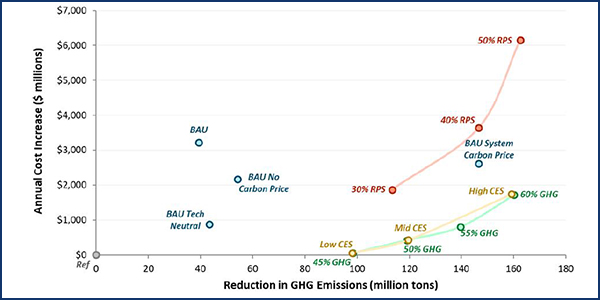PJM can attain extensive decarbonization with lower costs to consumers by 2030 through the pursuit of market-based policies like carbon pricing instead of relying on various state clean energy policies and subsidies, according to a new study released Wednesday.
The study, “Least Cost Carbon Reduction Policies in PJM,” was prepared by California-based consulting firm Energy and Environmental Economics (E3) on behalf of the Electric Power Supply Association (EPSA). It found that greenhouse gas emissions could be cut by 80 million metric tons, or roughly 28%, across the PJM region by 2030 with a carbon price of $10/ton. Such a price would keep annual costs at $2.8 billion less than the “business-as-usual” approach that includes a “hodgepodge of state and local clean energy policies,” it said.
Status quo policies are more expensive and less effective than a regional approach on carbon pricing, the study found, with existing state carbon policies and subsidies projected to increase electricity costs by more than $3 billion in 2030 and achieving less than half (40 million metric tons) of emissions reductions that could be achieved through a competitive, market-based approach.

Arne Olson, E3 senior partner | EPSA
Arne Olson, E3 senior partner and the lead author of the report, said it found that the most effective carbon policies for PJM will be ones maximizing choices for market participants and that will “leverage resource and geographic diversity” across the RTO.
“Carbon pricing is shown to be the most efficient way to achieve deep levels of carbon reductions,” Olson said.
The E3 study comes on the heels of FERC: Send Us Your Carbon Pricing Plans.)
Olson said the study examined carbon-reduction policy cost impacts through 2050 and was designed to provide baseline information for PJM’s stakeholders and policymakers as they decide the best ways to balance costs, reliability and the environment related to electricity generation.

Installed capacity and annual generation in a PJM system under 80% GHG reduction by 2050 goals | E3
Instead of constraining resource choices, Olson said, emissions can be efficiently and effectively reduced without hampering reliability by: a regional carbon price; encouraging competition and innovation; and allowing all resources and technologies to compete on a level playing field, including natural gas generation. Olson said the constraint of resource choices through state mandates and incentives increased costs in every scenario analyzed.

EPSA CEO Todd Snitchler | EPSA
E3 also found that 50 to 90 MW of “firm, flexible natural gas generation” will be needed in PJM through 2045 to provide reliability. To meet 100% net-zero carbon emission targets, the report said, the development and innovation of “yet-to-be-developed technologies” will be necessary, with carbon pricing providing the best path to provide incentives for innovation instead of state subsidies.
EPSA CEO Todd Snitchler said the report’s findings make clear that competition is key to a “more affordable, reliable and cleaner energy future.”
“We have the tools we need to succeed right in front of us, with PJM’s markets already saving customers money and driving down carbon emissions,” Snitchler said. “This data should inform smart policy decisions in PJM and other markets — and EPSA and our members look forward to aiding that effort as competitive power suppliers continue to provide what customers, markets and the grid demand.”


